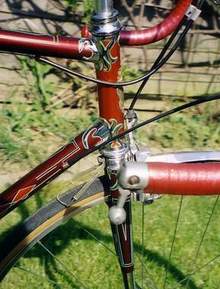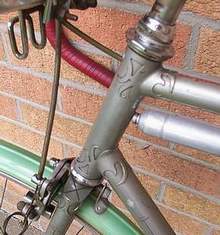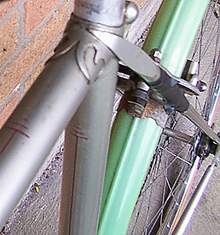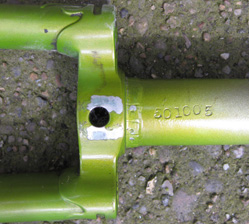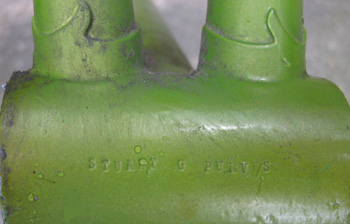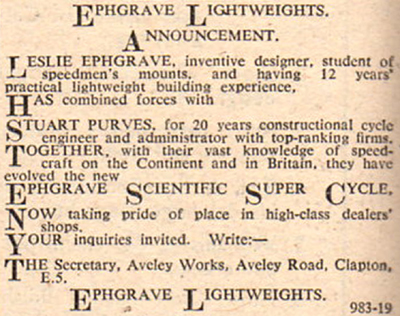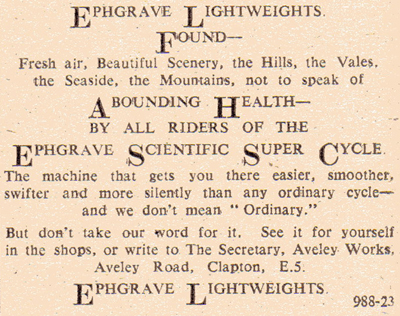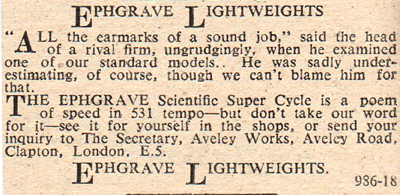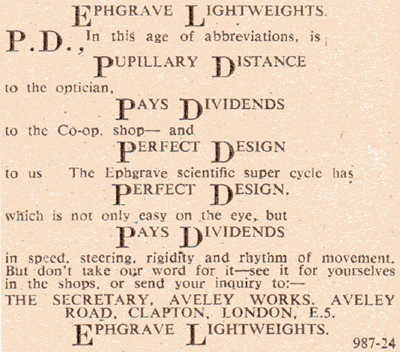Purves, Stuart
Posted: Thursday 04th June 2020
Stuart G Purves was an impressive man at 6’ 3” and weighing 16 stone according to his brochure, which shows a drawing of him looking very suave with shirt and tie, moustache, slicked back hair and holding a micrometer.
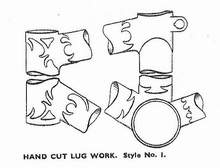
The brochure believed to be about 1951, says that he had a frame-building career of some 25 years, having built frames for many of the leading cyclists of the time. The frames were sold as Stuart Lightweight Cycles and he was based at 17 Streatham Hill London SW2. These premises were in a yard at the rear of Luxury Cars Ltd.
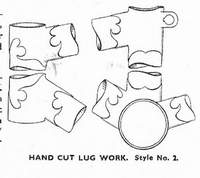
Mick Butler says that “he worked for Claud Butler at the original Manor Street works in Clapham, South London as a frame-builder cum welder, cum engineering technician. During World War 2 he was promoted to a managerial position in the firm as either Works Manager or Design Foreman but following a row with Claud Butler in the late 1940’s, he left Claud’s and set himself up as a self-employed frame-builder.”
It was very common during this period for personnel in the frame-building trades to have these monumental rows followed by departures to set up one’s own business or to go to another builder.
There is some confusion as to when Purves set up his business, as Mick Butler says: “From my own records, I have copies of Purves adverts from the 1949 programme of the Brighton to Glasgow Six Day Cycling Race and a advert from Cycling November 15th. 1951. It is generally thought that the firm only survived until 1955. What is puzzling is that there are 1950 adverts in Cycling for Ephgrave’s stating that Stuart Purves was Works Manager at the Avely Works. Mick was told that due to his gigantic reputation he brought a lot of work Les Ephgraves way. Apparently Les was none too pleased with all these orders as he wanted to stay a small scale builder. Stuart Purves left Ephgrave’s over this disagreement.”
On 8th November 1951, at the time of the national Cycle Show, Purves advertised his own show of machines in his workshops and displayed actual frames built for customers stating that all of his frames were to “show-case finish”. He says that he was too busy to build special frames for a show which implies that his machines were in great demand as November is not usually the peak time for building.
“His outside interests included horse racing and watching cricket and football. Apparently he preferred these pursuits to frame building and his business suffered, with would-be owners waiting for many months for their orders. He then had heart trouble and the frame building business was abandoned. It is rumoured that he finished up working as a turf accountant, an occupation that readily suited his love of horse racing.”
“He was the older brother of Jimmy Purves of the Vegetarian C.A.C. who was a post war, R.T.T.C 24-hour champion, and who also died at the early age of 41. This information was taken from a letter in Cycling May 2nd.1981 by a Mr. H.E. Halliday, a former work mate of Stuart’s at Claud Butler’s.”
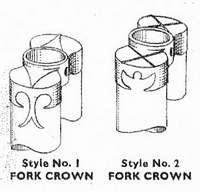
As to his frames, in and around 1951 Stuart Lightweight Cycles produced solos and tandems in either welded lugless form or traditional brazed frames in two lug styles Number 1 and Number 2. His welded frames were selling at £10 12s 6d, The style 1 frames were £16 15s 6d and the style 2 frames £14 17s 6d. The tandem frames were £27 10s 0d. The frames were finished in any shade of enamel or lustre with contrasting lines and lugs picked out in gold or to match lining.
His brochure makes great emphasis on ‘Stuart Craftsmanship’ and uniquely, I think, would produce a blueprint of the frame for the purchaser upon payment of a deposit of £1 1s 0d or a Guinea as it was known. He claims to have studied cycles as designed in France, Italy and Belgium and used this knowledge to produce the Stuart Cycle.
He recommends massed-start machines to be built with 72° parallel lugs, 2½” fork rake, 17¾” chainstays and 10¼” bottom-bracket height: this was regarded as the classic build for massed-start in the 50s.
For time-trial he recommends 73° head tube with the seat tube angle adjusted with a steeper angle for the shorter rider and shallower for the tall – this of course helps to adjust the top tube length to suit. The fork rake is given as 2¼”.For track he offers 73½° head (as opposed to the usual 74° of the time) with matching seat angles. Bracket height of 10¾” for British tracks and 6½” cranks, but for grass track 11¾” with 6¾” cranks.
These designs follow what was very popular fashion at the time.
He built his frames with 2” rear end slots for both road and track giving the widest option to change fixed gears without changing the length of the chain.
As well as contributing to the above, Mick Butler also made the following observations on Stuart Purves:
“I originally came from West London in an area known locally as the North Pole, very close to Portobello Road, so London makers fascinate me, especially the ones which have their roots from Claud Butler’s. The first Stuart Purves frame I saw was at Herne Hill in 1959. It was amongst all the others spectators’ bikes at a Champions Meeting and was next to where I had parked my own bike. This track bike just oozed quality and I even waited for the owner to turn up at the end of the meeting so I could find out some more about the maker. This chance encounter always made me determined to get one of Stuart’s frames. It eventually took me forty-four years to acquire one, which is the Silver Road Path No.1 above.
Because of this interest in Stuart Purves I have unearthed some facts about him taken either from catalogues (of which I think I have everyone Stuart produced), Cycling’s and conversations with workmates of his or just general cycling club gossip. I am almost certain that he started building under his own name in 1947. The workshop at 17 Streatham Hill was a lock-up garage between Telford Avenue and Palace Road. Stuart Purves had been in charge of the drawing office at Claud Butlers and I have spoken to Doug Taylor who was a draftsman there. In those days they use to draw the specials (one-offs) full size on cartridge paper for the builder to braze up to.
Les Ephgrave built most of the specials in the billiard hall near the works. Doug said that Butler’s built for anyone but unless you saw them after being enamelled with transfers fitted you had no idea who. I have also been told that to get tubes and frame building materials just after the war that a lot of ducking and diving (fiddles) were used to obtain stuff for the home market. This was the period of export or die.
A letter in Cycling May 2nd 1982 from H.E.Halliday refers to a row between Stuart Purves and Claud Butler in the early 50’s. Ray Bradley also told me that Stuart had worked on Government contracts during the war years at Claud’s building radar and radio masts. Stuart also built frames for Algurns along with another former Rotrax builder in Garrett Lane, Tooting. Several conversations with old cyclists came up with the story that Stuart Purves, Jimmy Long (Jimmy Long was one of the top builders at Bates Comely Bank he started up on his own just after the finish of the second world war) and Pat Skeat’s main source of income was from building steel extensions (stems) either for the trade or to customers specification. They were all renowned frame builders but it was quicker and easier to make stems and very profitable. I have an advert showing the Purves stem.
I have the original bill of sale for my frame built in 1951. The frame number is 51801. There is also another VCC member who has frame number 511007. Stuart numbered his frames thus; year first, month next and frame number. So we have 1951-August-frame number. The other number would be same year but October. The month number was allocated when the order and deposit was placed. Typical delivery time from initial order to delivery was approximately eleven weeks. Both of these frames are Number One Models. I have also seen a Number 2 with frame number 52101, which is 1952- January-01.
Stuart Purves also went into partnership with Bob Wakefield circa 1952. Bob was chief mechanic to the Milk Race for a number of years. I know of only six frames still in existence. How many he made I honestly don’t know but I would be very surprised if it was more than 250 in total.
Claud Butler was heavily involved with sponsorship and the inception of the League right from the start. He put up prizes, lent a van and a team mechanic, but with the ’48 Olympics coming up he cooled a little bit with the League as the NCU riders such as Harris and Banister were on Clauds for the Wembley Olympics. Everyone knows that no love was lost between the League and the NCU so it would be impossible to be involved with both at this time. I think it possible that he gave Stuart Purves and perhaps the Ephgraves his blessing to do his League orders and let them go on their own. I am postitive that Stuart built his own frames at first and then later on used Ephgraves. I think there was a trade off as Les needed Stuart to draw the full scale drawings for him to build to, that’s why I think you see Ephgrave’s advertising Stuart as their works manager when Stuart still had his workshop in South London. Stuart Purves even sponsored a League London road race.
During a CTC GHS ride in April, a friend from the north bank of the Humber was approached by a man with an Ephgrave for sale. Knowing my interest in old bikes she passed on the contact details, and I eventually met the owner at the Humber Bridge car park. He explained that he had bought it through an advert for Saville Stores in Cycling in the early 1960s as an Ephgrave. At a later date he had the frame repainted in a mustard shade of green – originally it had been finished in a lighter metallic type of green, and the Ephgrave transfers were lost.
You can see from the photograph that it was in a bit of a state. I couldn’t find an LE frame number, but it looked good, so the deal was done. Later that day I completely dismantled it, removing 1970s Sugino cranks and other non-period components, and sure enough – no LE number, but instead, a neatly stamped ‘Stuart G Purves’ on the bottom bracket and matching frame and fork numbers: 501005. I already have a Purves – refinished a few years ago, but what startled me on checking the number, was that it is 501006. Both made, or ordered consecutively, in October 1950.
From discussions with Mick Butler, and other known owners, I now have a list of six frames. So I know of 501104, 51801, 511007 and 52101. As Mick thinks that Purves started building in 1947 and continued, perhaps to 1955, it is interesting to ponder why known frames span a mere three years. One possibility is that he only used the year/month system for a short time. On the subject of total number made, we know he could make at least seven in a month, which would be 84 per year. Over eight years that would give a maximum production of 670, way more than the 250 estimated by Mick as realistic.
It is also possible that some of his frames were built for other companies and bore their frame numbers. As for my frame I am guessing it was refinished by Ephgrave before coming up for sale, as the last owner was surprised to learn that it was more than 10 years old when he bought it. If any subscribers own a Purves frame I would like to add it to a database and it would also be good to have any stories or memories of the machines and the man, though I would be delighted to learn that someone has already started this task and to hand over what little information I have!
In response to the above Alvin Smith has done some research into the link between Purves and Ephgrave:
Ephgrave and Purves from advertisements in Cycling
The story from these few advertisements appears straightforward, but what the story I read doesn’t tell us is how these men worked together- for that Peter Holland’s and Mick Butlers’s accounts are far superior.
There are persistant accounts of how Ephgrave, when still in employment by Claud Butler, made frames for sale to clubmen (perhaps selected athletes whom he favoured) and sold them at competition events from 1946 onwards. When I bought my frame the original owner was said to have purchased it in 1947 – just unfortunately though it carries the number LE 1612 and must therefore be a 1952 frame- memories and vendors don’t always play fair! Incidentally, the first time I could find an Ephgrave cycle offered for sale was in Cycling’s secondhand sales column for 7 July 1948; isn’t that a more reasonable time to find such a machine?
In tracking adverts for Paris Cycles in Cycling a few years ago I came across the advertisements described below. They appear to tell a tale. The first one was on 14 April 1948. This was placed therefore placed some two months before Peter Holland says the firm was registered (June 1948). In it, Ephgrave Lightweights made their first announcement using a layout that seemed to become a house style with its inset text items, opening and closure by the firm’s name with overlarge initial capitals and the figment of bureaucracy implied by the “The Secretary”:-
This series of advertisements never appeared again in Cycling and indeed was probably never needed – the small firm had more than enough work on. Who was the Secretary –was that Les Ephgrave’s brother? Or could it have been the butcher whose shop window also served as a display area just around the corner on Upper Clapton Road?
All these advertisements stand out from the rest of the advertisements in Cycling –they have an elegance of layout, an almost lyrical approach in their choice of words and phrasing but they stop short of just one attribute –rhyme.
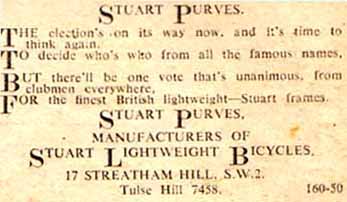
Now look at a separate advertisement that can be found in Cycling for 25 October 1951 –and remember the rest of the world had moved on since 1948. But look at the layout, the capitals, and the ideas.
Interesting to consider where else we have seen such a lay out –with a slightly off beat approach to selling bicycles – and just look – now we do have rhyme! Of course the two sets of advertisements could have come from the same small or even large firm of advert copy writers – but I prefer to think the evidence suggests that all of them came from the pen of Stuart Purves!
Following on Alvin’s piece above, two readers, Derek Athey and Mick Butler, have pointed ot that this advertising style is in fact an in-house style used by Cycling for many of its small adverts.
Regarding Stuart Purves and frames built by him. Stuart and Les Ephgrave left the employment of Claud Butler almost together, only a matter of weeks or months in their respective departure dates. Les had already been taken off piece rate at Clauds and was building under the billiard hall which was just down the road from the works. Stuart and Doug Taylor from Clauds drawing office were doing the full scale drawings for Les to build from. Les was already building Ephgraves and Butlers plus the specials for Claud from the billiard hall.
When Stuart left Butler he had no premises to build frames from. So Stuart in true journeyman fashion went on a modern day tramp. He built out of Algurns – Garrett Lane where he worked alongside Brian Packer ex-Rotrax builder (Brian Packer went on to build at R.H.Wakefilds who Stuart Purves went into partnership with). R.H.Wakefields – Tooting, Evelyn Hamilton’s – Streatham, Stan Butchers – Acres Lane. These are the four that I definitely know for sure, cycle gossip has mentioned loads more but I know for sure he built at these locations. He was also closely connected to E.H.Young – Lee High Road, F.Taylor – Stonebridge Park N.W.10 and A.F.Mills of Welling Kent And of course at Ephgraves. Later on he built out of a lock-up in Streatham Hill very close to the Telford Avenue tram depot.
This is why I think he only built approximately 250 Purves frames, he was too busy building for other lightweight shops and drawing the full scale drawings for Les Ephgrave to build from. After all he was Les’s works manager for quite a long period…
The original owner of my track bike ordered his road bike in the same year and waited nearly two years for delivery!!! Three to four months was the normal waiting period for a Purves frame.
Regarding “Cyclings” there was an item about Stuart leaving Ephgraves, maybe someone hs this edition of Cycling? The earliest frame I have ever seen was 1948 but was told for certain that he stated in 1947 by the owner. Mick also points out that Stuart Purves only ever fitted transfer type headbadges.Purves only ever fitted the laurel reef and olympic ring transfer headbadge, identical to the seat transfer. The metal Stuart headbadges have nothing to do with him and probably used by a firm in Forres Scotland?
Regarding Alvins observations about the style of Ephgrave and Purvis adverts in Cycling. This is called HOUSE STYLE in the PRINT and was typical of Temple Press Bowling Green Lane. Just look at any small claassiified adverts in Cycling for this period and all the adds with similar number of words are identical.
Mick Butler London Typographical Society (Later London region N.G.A) ex Temple Press
Posted: Thursday 04th June 2020
Contents
- Overview
- The brochure
- Mick Butler
- Mick Butler
- Horse racing
- Traditional brazed frames style
- Time-Trial
- Frames with 2” rear end slots
- Style lugs and matching fork crown
- Mick Butler
- About Frame built in 1951
- Partnership
- Nigel Land
- Number stamped on fork column
- Alvin Smith
- Ephgrave and Purves
- Advertisements
- Series of advertisements never appeared
- STUART PURVES
- Mick Butler
- Cyclings
- Style of Ephgrave
This article appears in the following categories.
Upcoming Events
Whether you are looking for a gentle social meet up, or a 100-mile ride browse the community’s upcoming events and plan your next weekend outing.

